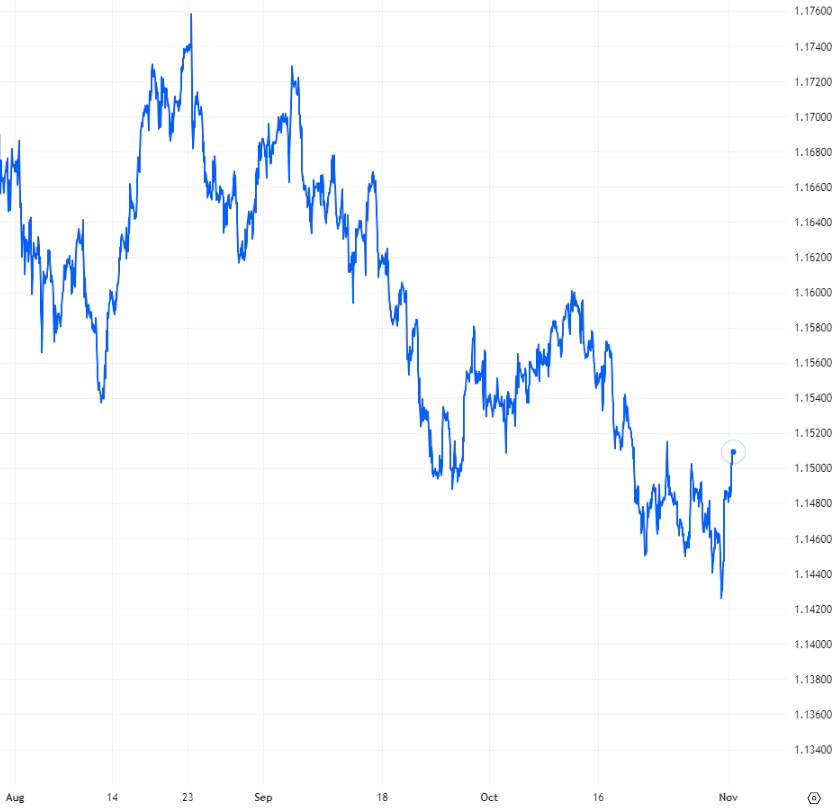GBP-EUR Exchange Rate Strikes 5-Month Low in October
Ongoing economic pessimism in the UK was compounded by the release of the finalised manufacturing PMI on 2 October.
Despite returning a marginally higher-than-forecast figure of 44.3, the reading was among the worst over the last 14 years as output continues to decline in the UK – indicating that the brakes continue to be applied to the economy.
The pound soon fell to a six-day low against the euro, before rebounding off the 1.15 level. Hawkish comments from European Central Bank (ECB) Chief Economist Philip Lane boosted the single currency after he outlined the upside risks to inflation and warned that “more work needs to be done” – raising bets of further rate hikes from the central bank.
The GBP-EUR pair firmed following the release of a higher-than-forecast finalised services PMI for the UK, with a final reading of 49.3 significantly exceeding the expected 47.2.
The slower-than-expected contraction in the powerhouse services sector pointed to a surprising level of economic resilience – although fears of an economic slowdown persisted.
After treading water for a short spell, the pair gained traction amid a combination of economic data and Bank of England (BoE) tailwinds. UK PMIs exceeded expectations before weak German numbers weighed on the euro. Comments from BoE Governor Andrew Bailey and Deputy Ben Broadbent implied that inflation was easing in a controlled manner, giving the pound a lift.
The UK currency briefly edged above the 1.16 benchmark against the euro for the first time in over three weeks on 11 October, before lacklustre GDP data reignited concerns about the health of the UK economy – knocking the pound off its perch.
Signs of growing looseness in the UK labour market extended the pound’s losses on 17 October, as average earnings (excluding bonuses) ticked downward, indicating that inflation pressures are easing.
Having rebounded off a two-week low just above the 1.15 level on 18 October as UK inflation data printed above forecasts at 6.7%, the pound sunk to a five-month low in the 1.14 mid-range.
The catalyst for the slump was a lamentable retail sales print from the UK, which showed the cost of living crunch caused sales volumes to crash.
The pound’s recovery was accelerated on 24 October by the release of flash PMIs from the Eurozone and the UK – pushing it into the 1.15 mid-range against the euro. Both October surveys painted a gloomy picture of business activity – but for the bloc it showed a deepening contraction, sending the single currency lower.
After dropping back into the 1.14 range amid robust German business data, the GBP-EUR pair rallied on 26 October when the ECB announced it had paused its interest rate hiking cycle. As expected, the central bank voted to leave borrowing costs unchanged for the first time since it started its tightening cycle 15 months ago.
With little data from the UK economy for investors to digest at the end of the month, the focus shifted to the BoE’s interest rate decision at the start of November.
GBPEUR: 3-Month Chart

Looking ahead
The BoE’s expected to keep exchange rates paused for a second month in a row on 2 November after almost two years of consecutive hikes to cool inflation.
Influential data from the UK economy in November: BoE interest rate decision (2 November), GDP (10 November), ILO Unemployment Rate (14 November), Consumer Price Index (15 November), Retail Sales (17 November), S&P Global/CIPS Composite PMI (21 November).






